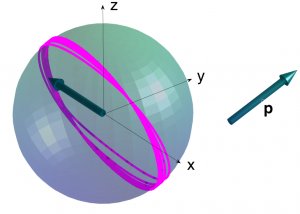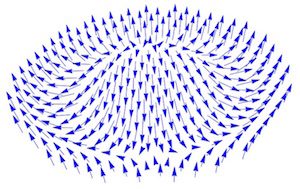Antiferromagnets are prospective materials for spintronic applications as they show fast magnetic dynamics, low susceptibility to the magnetic fields and produce no stray fields. They have nontrivial magnetic structure, more magnetic degrees of freedoms and peculiar dynamics, as compared to ferromagnetic materials. 
Application of antiferromagnets for information storage and development implies manipulation of states with the use of the magnetic fields or electrical currents. For this one needs to study the mechanisms that govern behaviour of antiferrantiferromagentic nanoparticles and textures in the presence of the external fields. My current reseach is focused on the problems of nonequilibrium magnetic dynamics of antiferromagnets induced by spin-orbit torques, temperature gradients, mechanical stresses etc. Strong magnetoelastic coupling, which is a peculiar feature of many antiferromagnetic materials, makes these problems more complicated and more facinating.
As a teacher I have a great experience in the field of quantum information theory and hope to find a way to use antiferromagnets as the active elements of quantum bits.
Publications (Highlights)
- Narrow-band tunable terahertz detector in antiferromagnets via staggered-field and antidamping torques. O. Gomonay, T. Jungwirth & J. Sinova, (Phys. Rev. B, 98, 104430 (2018)).
- Spin Hall magnetoresistance in antiferromagnet/normal metal heterostructures, J. Fischer, O. Gomonay, R. Schlitz, K. Ganzhorn, N. Vlietstra, M. Althammer, H. Huebl, Matthias Opel, R. Gross, S.T.B. Goennenwein, S. Geprägs.(Phys. Rev. B97, 014417 (2018))
- Antiferromagnetic spin-texures and dynamics. Part of a collection of reviews on antiferromagnetic spintronics.O. Gomonay, V. Baltz, A. Brataas, Y. Tserkovnyak.(Nature Physics, 14, 213 (2018))
- Spin Colossal Magnetoresistance.Zh. Qiu , Dazi Hou, J. Barker , K. Yamamoto, O. Gomonay, and E. Saitoh. (Nature Materials, 17, 577 (2018))
- "Concepts of antiferromagnetic spintronics”. O. Gomonay, T. Jungwirth, and J. Sinova (Phys. stat. sol. 11, 1700022 (2017))
- “High Antiferromagnetic Domain Wall Velocity Induced by Néel Spin-Orbit Torques”. O. Gomonay, T. Jungwirth, and J. Sinova (Phys. Rev. Lett. 117, 017202 (2016))
- “Controlling the switching field in nanomagnets by means of domain-engineered antiferromagnets”. E. Folven, J. Linder, O. V. Gomonay, A. Scholl, A. Doran, A. T. Young, S. T. Retterer, V. K. Malik, T. Tybell, Y. Takamura, J. K. Grepstad (Phys. Rev B 92, 094421 (2015))
- Spintronics of antiferromagnetic systems (Review article). O. V. Gomonay and V.M. Loktev. (Low Temperature Physics, 40, 17 (2014))
- Spin transfer and current-induced switching in antiferromagnets. O. V. Gomonay and V. M. Loktev (Phys. Rev. B , 81, 144427 (2010))
Awards & Fellowships
- DFG grant "SHARP: Spintronics with Antiferromagnets and Phonons" (2018)
- State prize of Ukraine in science and technologies "Functional properties of the bulk and surface ordered systems and fabrication of new metal-containing materials and structures" (2015)
- Grants from the International Science Foundation (ISF) and American Physical Society (1992,1994, 1995, 1998)

